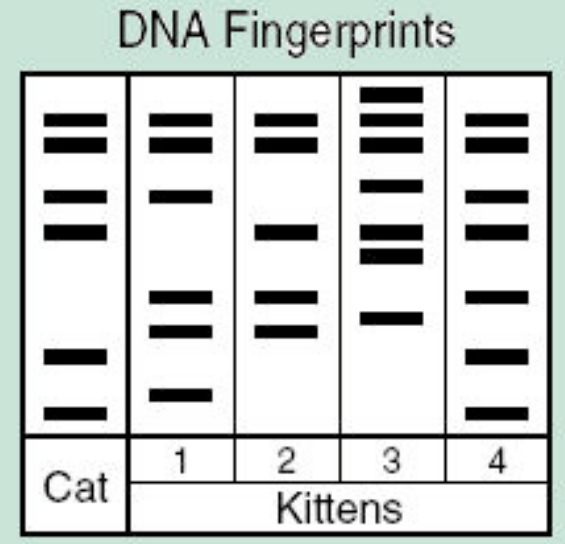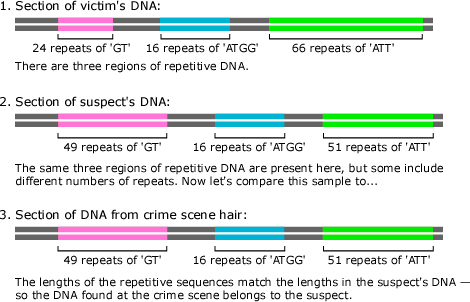Which of These Is Not a Use for Dna Fingerprinting
DNA-DNA hybridisation is a technique of molecular biology which is used to measure the similarity between DNA sequences. Polymerase chain reaction PCR has been used to produce many copies of specific STR and VNTR sequences.

Biotechnology Biology Quiz Quizizz
Determining the father of a child.

. Paternity or Maternity Disputes It helps to find out the real genetic mother father and offspring. Identifying the person whose DNA was left at a crime scene. These repeats act as genetic markers and every individual inherits these repeats from their parents.
DNA fingerprinting plays an important role in determining a parent of a child. Additionally the issue of genetic privacy and when criminal investigators can access this information is an ongoing ethical discussion. - this is significant because if a sample of DNA is not large enough it can not be used in a DNA fingerprinting lab.
Figuring out which species are more closely related. Molecular Basis of Inheritance. The process of DNA fingerprinting was invented by Sir Alec Jeffrey at the University of Leicester in 1985.
Parentage testing and relatives tracking. The applications of DNA fingerprinting are as follows. Which of the following is not associated.
Human Genome Project and DNA Fingerprinting. Gel electrophoresis or sequencing can help n fragmenting the DNA. Thus every individual has a particular composition of VNTRs and this is the main principle of the DNA fingerprinting technique.
In case of the change in gene frequency or genetic. Apart from these two fields it is also used in determining the frequency of a particular gene in a population which gives rise to diversity. Which of the following is not associated with DNA fingerprinting.
PCR based DNA fingerprinting relies on microsatellites like STRs Short tandem repeats and VNTRs. The DNA fingerprinting can be used to solve crimes and in paternity dispute cases. Hence zinc finger analysis which is related to proteins is not required for DNA fingerprinting.
DNA fingerprinting is a technique that simultaneously detects lots of minisatellites in the genome to produce a pattern unique to an individual. If an organism undergoes reversible high-frequency DNA reorganization at specific loci in association with phenotypic switching as occurs in Salmonella enterica serovar Typhimurium Escherichia coli and Borrelia hermsii or if an organism undergoes irreversible DNA reorganization at specific loci in association with antigenic switching as occurs in. Human Lineage It is also used to study human lineages.
A guy by the name of Alec Jeffreys a British geneticist developed the technique of DNA fingerprinting in 1984. Which of these is NOT a use for DNA Fingerprinting. So the correct answer is Zinc finger analysis.
Up to 24 cash back Genetic fingerprinting 90 or more of DNA does not carry nucleotide triplets that code for proteins The non-coding DNA is often called junk DNA but this only means that its functions have not yet been discovered Some of the non-coding regions consist of repeated sequences of nucleotides For example -C-A-T-G-C-A-T-G-C-A-T-G-C-A-T-G- The. Personal identification has been a boon in many fields namely crime investigation and forensic department. Individuality It helps to differentiate one human being from another with the exception of monozygotic twins.
This process comprehensively and accurately recognizes the DNA of a person compared to any other technique available. DNA Fingerprinting- Principle Methods Applications. These repeating sequences do not affect the function of genes but they are unique to every individual.
Finding the likelihood of inheriting a genetic disorder. The probability of having two people with the same DNA fingerprint that are not identical twins is very small. The DNA is extracted from the body and then is amplified using Polymerase chain reaction.
DNA fingerprinting also called DNA profiling or forensic genetics is a technique that uses DNA analysis and comparison to resolve legal problems such as paternity tests and inheritance matters establish identity in criminal cases where biological evidence is found at crime scenes and identify victims of mass disasters and missing persons from. - amplifies a single or several fragments of DNA. Applications of DNA Fingerprinting.
Unlike the RFLP DNA fingerprinting method it does not use restriction enzymes to cut the DNA. Ocedure used to separate and analyze DNA fragments by placing a mixture of DNA fragments at one end of a porous gel and applying an electrical voltage to the gel Micropipette used to accurately withdraw and dispense very small amounts of reagents in the micro-liter range which is necessary for DNA. - artificial enzyme used in labs under perfect conditions in order to replicate DNA samples.
As discussed earlier the technique of fingerprinting is used for DNA analysis in forensic tests and paternity tests. He found minisatellites within all DNA. Even if it is available degraded DNA cannot be used for DNA fingerprinting.
The most prominent use of DNA fingerprinting is the personal identification. Police use these tests to determine whether the adult should keep the child or if that child belongs to someone else. This can work in suspected kidnapping cases and familial kidnapping cases too.
Collection of organic example blood spit buccal swab semen or solid tissue. This is a DNA fingerprint. DNA fingerprint testing can determine whether the two have a biological connection.
DNA fingerprinting or DNA profiling is a process used to determine the nucleotide sequence at a certain part of the DNA that is unique in all human beings. The sequence of those particular regions which are different amongst humans based on the DNA print can be.

Dna Fingerprinting Understanding Evolution

No comments for "Which of These Is Not a Use for Dna Fingerprinting"
Post a Comment